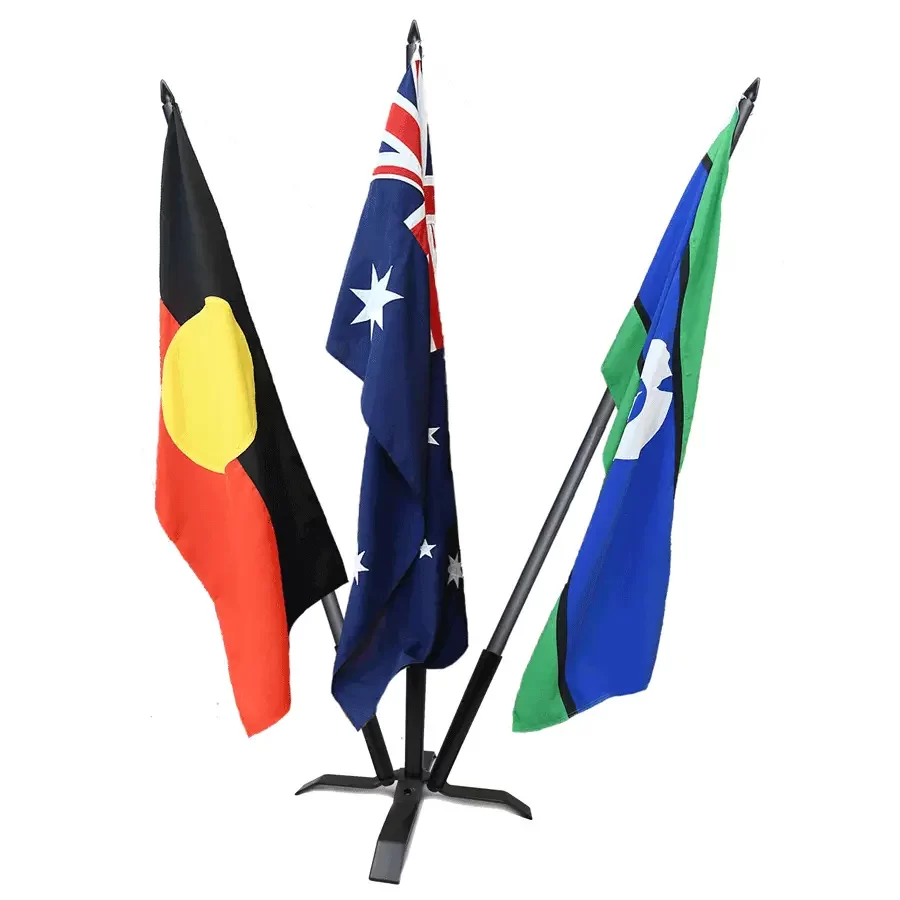Australian Capital Territory
The Australian Capital Territory (ACT), known as the Federal Capital Territory (FCT) until 1938, houses Canberra (nicknamed the “Bush Capital”) and has an area of 2,358 km².
Canberra is located in the northeastern corner of the territory, about 300 km (185 miles) southwest of Sydney, 465 km (290 miles) northeast of Melbourne, and 150 km (95 miles) from the coast. The entire territory lies between latitudes 35° and 36° S and extends some 85 km (53 miles) north to south and 53 km (33 miles) east to west.
The earliest evidence of Aboriginal occupation of the Australian Capital Territory dates from some 21,000 years ago. At the time of European settlement, the Ngunnawal were the main indigenous people in the region. Aborigines came to the territory’s mountains each year in late spring to gather and feast on Bogong moths.
Canberra was the name given to the new capital, which is rumoured to be a translation of ‘meeting place’ in the Aboriginal.
Map of the Australian Capital Territory
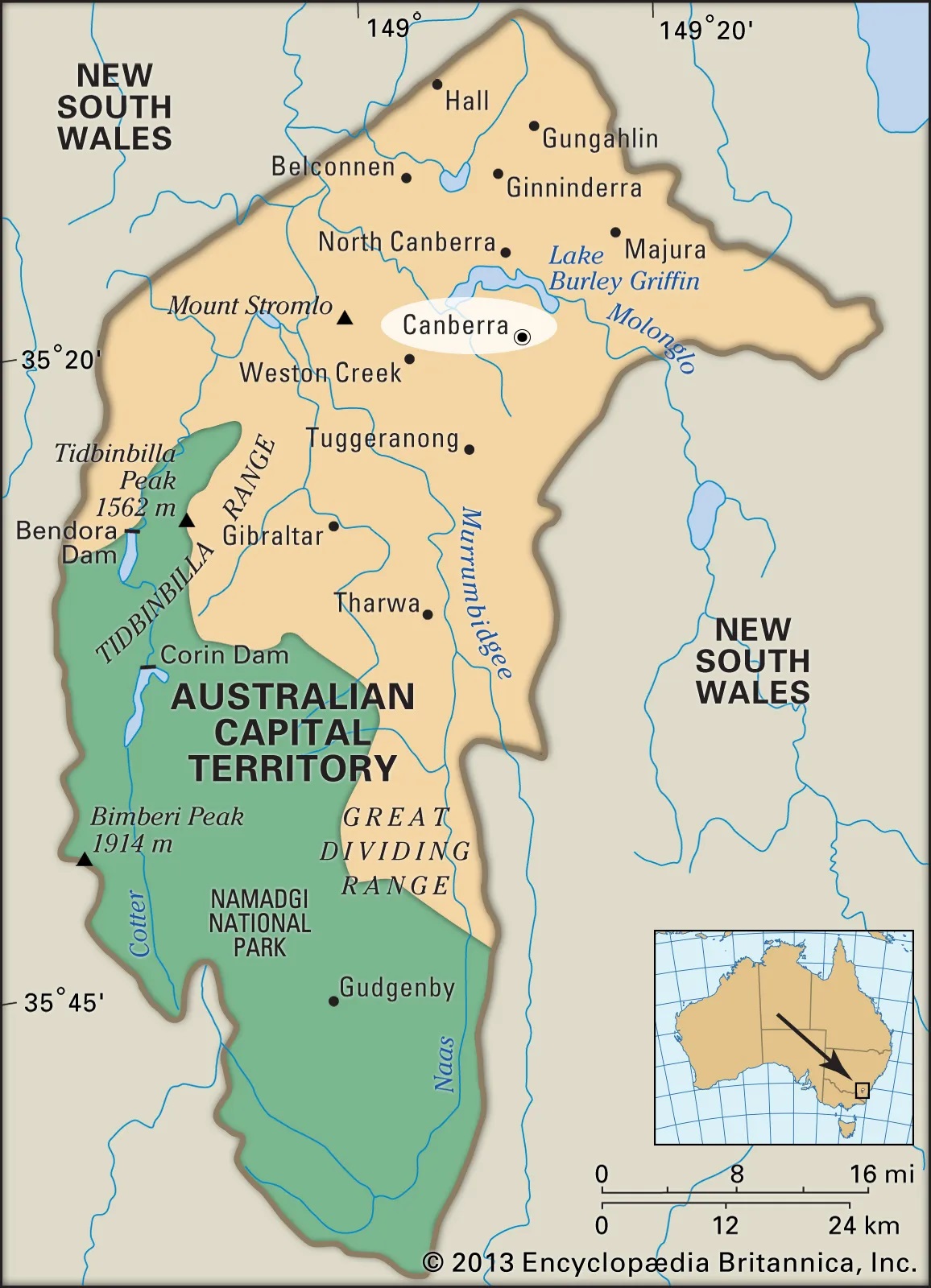
For more on the map https://www.britannica.com/place/Canberra
The Coat of Arms of the City of Canberra
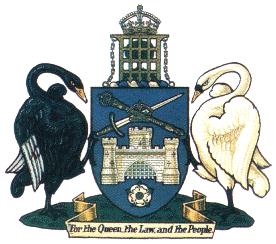 The creation of the Coat of Arms of the City of Canberra originated from a request by the Commonwealth Department of Defence to the Commonwealth Department of Home Affairs and Territories in July 1927. The request was made so that the Coat of Arms could be used on the newly commissioned ship, HMAS Canberra. In August 1927, the Federal Capital Commission (FCC) announced a competition to design a Coat of Arms for the FCC and the City of Canberra.
The creation of the Coat of Arms of the City of Canberra originated from a request by the Commonwealth Department of Defence to the Commonwealth Department of Home Affairs and Territories in July 1927. The request was made so that the Coat of Arms could be used on the newly commissioned ship, HMAS Canberra. In August 1927, the Federal Capital Commission (FCC) announced a competition to design a Coat of Arms for the FCC and the City of Canberra.
For more on the coat of arms
https://en.wikipedia.org/wiki/Coat_of_arms_of_the_Australian_Capital_Territory
Flag for the Australian Capital Territory
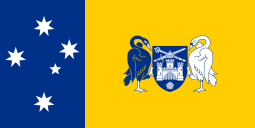 The current flag of the Australian Capital Territory was officially adopted by the Australian Capital Territory Legislative Assembly in 1993.
The current flag of the Australian Capital Territory was officially adopted by the Australian Capital Territory Legislative Assembly in 1993.
The flag differs from the Australian state flags as it is not a defaced Blue Ensign. The flag uses the Canberra city colours of blue and gold (which also happen to be the heraldic colours of Australia). The Southern Cross appears as five white stars on a blue panel at the hoist, whilst in the centre of the goldfield in the fly is the modified Coat of arms of the city of Canberra. The flag was designed by Ivo Ostyn.
https://en.wikipedia.org/wiki/Flag_of_the_Australian_Capital_Territory
Guidelines for the use of the ACT Flag [ 382 KB]
The Emblems of the Australian Capital Territory
The ACT also has a faunal, floral and mammal emblem.
All the emblems have no legislative requirements surrounding their use. These can be used by anyone on their publications, uniforms or websites.
Animal Emblem
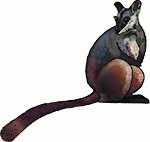 The Southern Brush-tailed Rock-wallaby was adopted as the ACT’s mammal emblem in November 2018.
The Southern Brush-tailed Rock-wallaby was adopted as the ACT’s mammal emblem in November 2018.
The Southern Brush-tailed Rock-wallaby is endangered and were last seen in the wild in the ACT in 1959. In 1996, Tidbinbilla Nature Reserve started a conservation program with a captive population of three animals, and since then, they have successfully bred over 60 animals. The Southern Brush-tailed Rock-wallaby also has significant cultural importance to the Ngunnawal people.
Bird Emblem
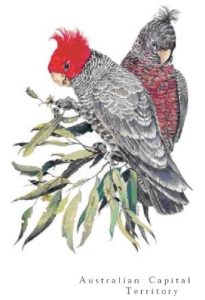 The Gang-gang Cockatoo was adopted as the faunal emblem for the ACT on 27 February 1997. Canberra is the only city in Australia where these distinctive ash-grey cockatoos live. During winter, small flocks are common in gardens around the city where they feed on pinecones, firethorn and hawthorn berries. They are often so busy feeding that observers can get close enough to admire their beautiful plumage. In summer, most of the flocks return to the mountain forests to breed in tree hollows. Their call is a distinctive sound resembling the sound of a squeaking gate. The Gang-gang Cockatoo is also the logo of the ACT Parks and Conservation Service.
The Gang-gang Cockatoo was adopted as the faunal emblem for the ACT on 27 February 1997. Canberra is the only city in Australia where these distinctive ash-grey cockatoos live. During winter, small flocks are common in gardens around the city where they feed on pinecones, firethorn and hawthorn berries. They are often so busy feeding that observers can get close enough to admire their beautiful plumage. In summer, most of the flocks return to the mountain forests to breed in tree hollows. Their call is a distinctive sound resembling the sound of a squeaking gate. The Gang-gang Cockatoo is also the logo of the ACT Parks and Conservation Service.
Floral Emblem
 On 26 May 1982, it was announced that the floral emblem for the ACT would be the Royal Bluebell. The Royal Bluebell is restricted in distribution to the high mountain areas of the ACT, south-eastern NSW and eastern Victoria. In cultivation, it is a frost-hardy ground cover, flowering in Canberra from late October until February. It does best in light soil enriched by organic material, in a sunny or semi-shaded situation. The soil should be kept moist but not waterlogged. The flower was named in honour of G.G. Wahlenberg, a former Professor of Botany from Uppsala in Sweden. It should be remembered that the Royal Bluebell is protected in the wild and should not be picked or collected.
On 26 May 1982, it was announced that the floral emblem for the ACT would be the Royal Bluebell. The Royal Bluebell is restricted in distribution to the high mountain areas of the ACT, south-eastern NSW and eastern Victoria. In cultivation, it is a frost-hardy ground cover, flowering in Canberra from late October until February. It does best in light soil enriched by organic material, in a sunny or semi-shaded situation. The soil should be kept moist but not waterlogged. The flower was named in honour of G.G. Wahlenberg, a former Professor of Botany from Uppsala in Sweden. It should be remembered that the Royal Bluebell is protected in the wild and should not be picked or collected.
For more on the emblems of the ACT, see https://www.cmtedd.act.gov.au/communication/flags
Colour Emblem
Dark Blue, White and Gold
For more on the Colour Emblems https://en.wikipedia.org/wiki/Australian_state_and_territory_colours
